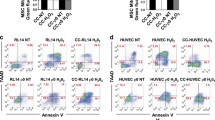Abstract
The capacity of mesenchymal stem cells (MSCs) to survive and engraft in the target tissue may lead to promising therapeutic effects. However, the fact that the majority of MSCs die during the first few days following transplantation complicates cell therapy. Hence, it is necessary to strengthen the stem cells to withstand the rigors of the microenvironment to improve the efficacy of cell therapy. In this study, we manipulated MSCs to express a cytoprotective factor, heme oxygenase-1 (HO-1), to address this issue. Full-length cDNA of human HO-1 was isolated and cloned into TOPO vector by TOPO cloning reaction. Then, the construct was ligated to gateway adapted adenovirus expression vector by LR recombination reaction. Afterwards, the recombinant virus expressing HO-1 was produced in appropriate mammalian cell line and used to infect MSCs. The HO-1 engineered MSCs were exposed to hypoxic and oxidative stress conditions followed by evaluation of the cells’ viability and apoptosis. Transient expression of HO-1 was detected within MSCs. It was observed that HO-1 expression could protect MSCs against cell death and the apoptosis triggered by hypoxic and oxidative stress conditions. The MSCs-HO-1 retained their ability to differentiate into adipogenic, chondrogenic, or osteogenic lineages. These findings could be applied as a strategy for prevention of graft cell death in MSCs-based cell therapy and is a good demonstration of how an understanding of cellular stress responses can be used for practical applications.




Similar content being viewed by others
References
Abdel-Mageed AS, Senagore AJ, Pietryga DW, Connors RH, Giambernardi TA, Hay RV, Deng W (2009) Intravenous administration of mesenchymal stem cells genetically modified with extracellular superoxide dismutase improves survival in irradiated mice. Blood 113(5):1201–1203. doi:10.1182/blood-2008-07-170936
Abraham NG, Kappas A (2008) Pharmacological and clinical aspects of heme oxygenase. Pharmacol Rev 60(1):79–127. doi:10.1124/pr.107.07104
Cao Y-A, Wagers AJ, Karsunky H, Zhao H, Reeves R, Wong RJ, Stevenson DK, Weissman IL, Contag CH (2008) Heme oxygenase-1 deficiency leads to disrupted response to acute stress in stem cells and progenitors. Blood 112(12):4494–4502. doi:10.1182/blood-2007-12-127621
Chamberlain G, Fox J, Ashton B, Middleton J (2007) Concise review: mesenchymal stem cells: their phenotype, differentiation capacity, immunological features, and potential for homing. Stem Cells 25(11):2739–2749. doi:10.1634/stemcells.2007-0197
Conget PA, Minguell JJ (2000) Adenoviral-mediated gene transfer into ex vivo expanded human bone marrow mesenchymal progenitor cells. Exp Hematol 28(4):382–390
Deramaudt TB, Da Silva J-L, Remy P, Kappas A, Abraham NG (1999) Negative regulation of human heme oxygenase in microvessel endothelial cells by dexamethasone. Proc Soc Exp Biol Med 222(2):185–193. doi:10.1046/j.1525-1373.1999.d01-130.x
Dulak J (2007) Changing faces of heme oxygenases. Antioxid Redox Signal 9(12):2043–2047. doi:10.1089/ars.2007.1833
Halabian R, Mohammadi MH, Salimi M, Amani M, Roushande AM, Aghaipoor M, Amirizadeh N, Ebrahimi M, Najafabadi AJ, Roudkenar MH (2010) Genetically engineered mesenchymal stem cells stably expressing green fluorescent protein. IJBMS 13(2):24–30
Kikuchi G, Yoshida T, Noguchi M (2005) Heme oxygenase and heme degradation. Biochem Biophys Res Commun 338:558–567
Prockop DJ, Gregory CA, Spees JL (2003) One strategy for cell and gene therapy: harnessing the power of adult stem cells to repair tissues. Proc Natl Acad Sci USA 100(Suppl 1):11917–11923. doi:10.1073/pnas.1834138100
Shu T, Zeng B, Ren X, Li Y (2010) HO-1 modified mesenchymal stem cells modulate MMPs/TIMPs system and adverse remodeling in infarcted myocardium. Tissue and Cell 42(4):217–222
Tang YL, Tang Y, Zhang YC, Qian K, Shen L, Phillips MI (2005) Improved graft mesenchymal stem cell survival in ischemic heart with a hypoxia-regulated heme oxygenase-1 vector. J Am Coll Cardiol 46(7):1339–1350. doi:10.1016/j.jacc.2005.05.079
Toma C, Pittenger M, Cahill K, Byrne B, Kessler P (2002) Human mesenchymal stem cells differentiate to a cardiomyocyte phenotype in the adult murine heart. Circulation 105(1):93–98
Tsubokawa T, Yagi K, Nakanishi C, Zuka M, Nohara A, Ino H, Fujino N, Konno T, M-A K, Ishibashi-Ueda H, Nagaya N, Yamagishi M (2010) Impact of anti-apoptotic and anti-oxidative effects of bone marrow mesenchymal stem cells with transient overexpression of heme oxygenase-1 on myocardial ischemia. Am J Physiol Heart Circ Physiol 298(5):H1320–H1329. doi:10.1152/ajpheart.01330.2008
Wang X, Zhao T, Huang W, Wang T, Qian J, Xu M, Kranias EG, Wang Y, Fan G-C (2009) Hsp20-engineered mesenchymal stem cells are resistant to oxidative stress via enhanced activation of Akt and increased secretion of growth factors. Stem Cells 27(12):3021–3031. doi:10.1002/stem.230
Wang W, Li W, Ou L, Flick E, Mark P, Nesselmann C, Lux CA, Gatzen H-H, Kaminski A, Liebold A, Lützow K, Lendlein A, Li R-K, Steinhoff G, Ma N (2010) Polyethylenimine-mediated gene delivery into human bone marrow mesenchymal stem cells from patients. J Cell Mol Med. doi:10.1111/j.1582-4934.2010.01130.x
Zhu W, Chen J, Cong X, Hu S, Chen X (2006) Hypoxia and serum deprivation-induced apoptosis in mesenchymal stem cells. Stem Cells 24(2):416–425. doi:10.1634/stemcells.2005-0121
Author information
Authors and Affiliations
Corresponding author
Rights and permissions
About this article
Cite this article
Hamedi-Asl, P., Halabian, R., Bahmani, P. et al. Adenovirus-mediated expression of the HO-1 protein within MSCs decreased cytotoxicity and inhibited apoptosis induced by oxidative stresses. Cell Stress and Chaperones 17, 181–190 (2012). https://doi.org/10.1007/s12192-011-0298-y
Received:
Revised:
Accepted:
Published:
Issue Date:
DOI: https://doi.org/10.1007/s12192-011-0298-y




